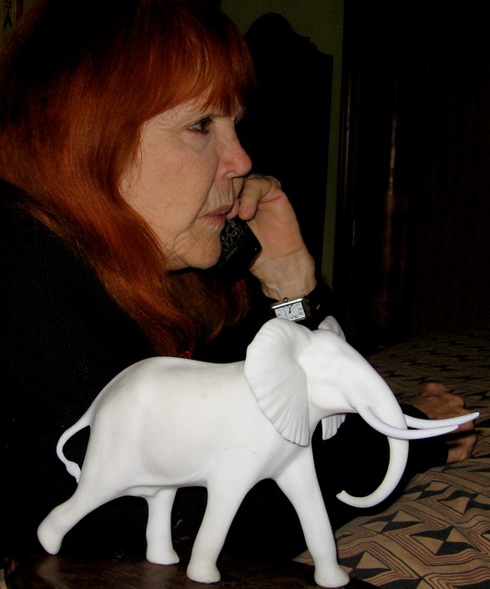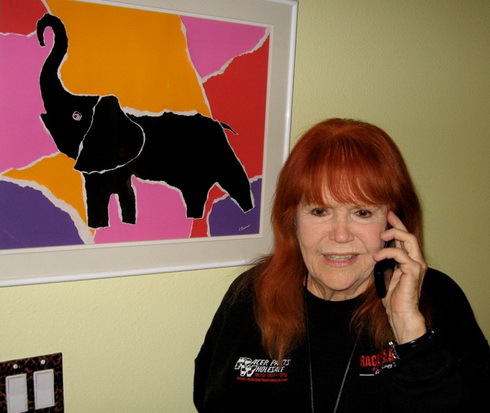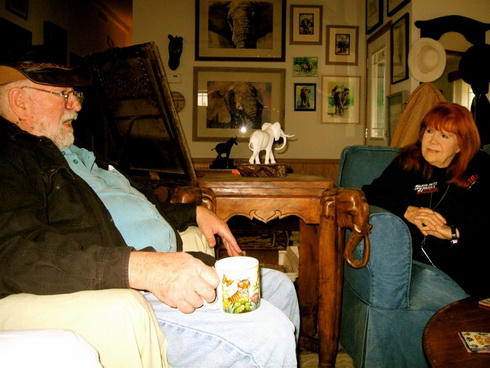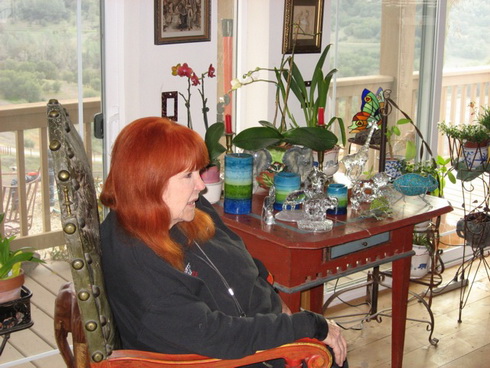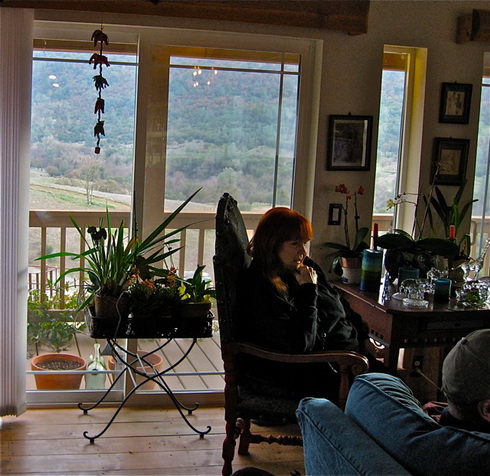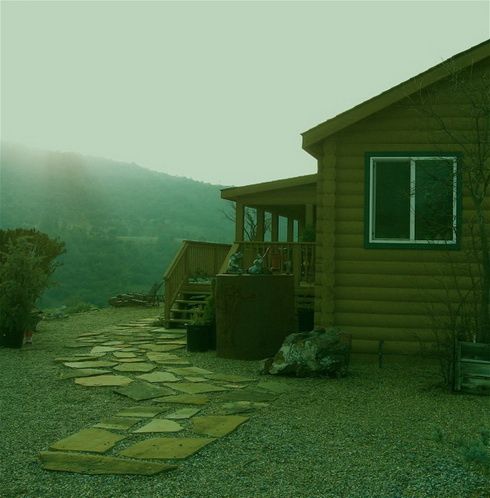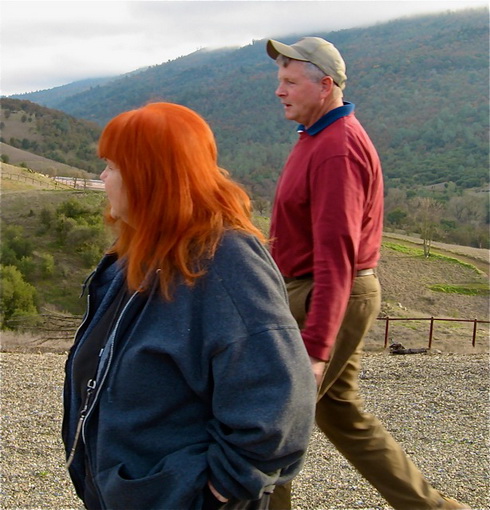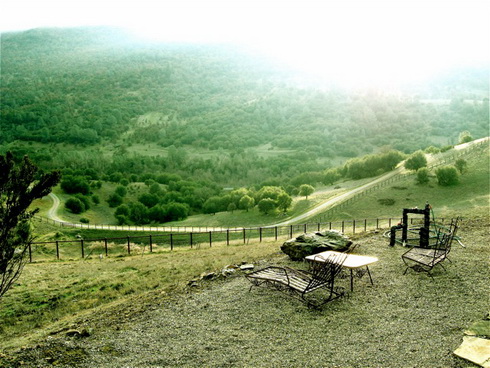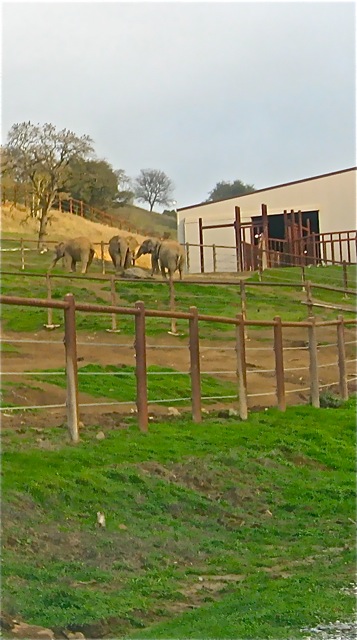The Deep Dark Past Of An Elephant Oasis
By LIONEL ROLFE
A hundred million years or so ago, or perhaps far less by some estimates, the sea beds then under the ancient ocean were thrust up into the heavens, and thus was the Sierra born. The cataclysmic rise left the eastern side of the mountain range rocky and steep and sheer. The western side is the older side, and the land is more gentle and sloping beneath the dwindling glacier at the top of Kiersarge Pass.
Actually, the mountain range is still young, compared to the Rockies in the center of the country and the Adirondacks in the east. The Sierra are still being formed, thrusting upward at a rapid rate – geologically speaking.
The Mother Lode is on the western side of the Sierra, a land seemingly made pastoral by trees and flowers and lush, wet green meadows, unlike the sheer walls of the eastern side. The gentleness is a bit misleading, since the Mother Lode was sculpted in a cradle made by the grinding of two great continental plates.
Now move through the years until 1849, and imagine you are in Angels Camp in the Mother Lode, immortalized in Mark Twain’s tales of the Gold Rush.
In the early winter days of 2009, the land undoubtedly did not look much different than it did in in Twain’s time. My wife Boryana and I sat with Pat Derby in her front room which looks out on Angels Camp. She was saying that the first miners arriving in the Mother Lode called it “seeing the elephant, because in this miraculous land it was then you could envision elephants as wonderful, miraculous creatures.”
To be completely accurate, I should say that we’re not looking at Angels Camp itself, but at a particular mountain right outside the front window that’s been there as a result of a geological anomaly even longer than the mighty Sierra itself. In Twain’s time, as in our time, the mountain, which is called Hog Back, lies on a direct line between Angels Camp and San Andreas.
Hog Back is in stark contrast to those peaks that make up the spiny ridge of the noble Sierra. Hog Back is a nice, small green mountain, although when you’re right up against it, it is still impressively huge.
YOU CAN GET A GLIMPSE OF HOG BACK FROM PAT DERBY’S FRONT ROOM
Derby’s better half, Ed Stewart, looked at the mountain with great respect as well and explained that if you went back enough millennia ago, some of the descendants of today’s elephants roamed the green hills from which Hog Back rises.
So it’s not unimportant that the dozen or so elephants Derby has brought to the more than 2,000 acres of this land known as ARK2000 has as its centerpiece the mountain. These may not be the tropical climes that elephants seem to prefer, but they will do. That’s why the Ark shelters the dozen or so elephants that now live here at night in warm barns. And, Derby pointed out, 200 or 300 years before Jesus, as winter descended, a talented military commander named Hannibal moved his Army on elephants over the Pyrenees and the Alps in order to battle the Romans.
It is no longer an Ice Age like it was when the elephants roamed Hog Back. Still, with the fog swirling around the mountain this particular morning, it looks cold enough, and even shivering and primeval enough to imagine we still live in an ice age.
As was said earlier, Hog Back is a geological anomaly, as close to a perennial as you can get in these parts. It is a special kind of rare mountain called a monadnock.
The name is from an Indian word that was used in New Hampshire to name Mount Monadnock. Ed said there’s another monadnock north of Sacramento. In Europe, such mountains are better known by the name inselberg. In Africa, a similar formation of granite is known as a koopie, which is an Afrikaan word.
Monadnocks are unrelated to the geology around them, and are older and more stable and perhaps less dramatic than the landscape on which they sit.
HOG BACK LOOKS DRAMATIC ONLY IF YOU UNDERSTAND WHAT IT IS.
ARK2000 has a more personal story than the geologic story of Hog Back and the green hills that surround it. The story belongs to Pat Derby.
The seed money for ARK 2000 initially came from actress Kim Basinger and her then husband Alex Baldwin. Ed said that his wife spends a great deal of her time raising money to pay the bills, which amount to close to $3 million a year.
A direct descendant of the great English poet Percy B. Shelley, Derby is from England. One of the side effects of their efforts, she notes, is that by managing to obtain the acreage on which ARK2000 sits, they have prevented the otherwise inevitable development “with houses, mini malls and golf courses.”
THE ELEPHANTS ROAM HOG BACK & ENVIRONS & SLEEP AT NIGHT IN SPECIAL BARNS.
When I first met Pat Derby more than 40 years ago, she was married to Ted Derby, and both were in the business of supplying animals for the movies. They were prominent in the field, and lived in Newhall and Saugus, 30 and more miles north of downtown Los Angeles.
Nearly a decade later, the Derbys were divorced but continued working together in their cause – saving wild animals from man’s brutality toward them. Shortly after they moved their animals to Buellton, about 150 miles up the coast, they divorced and divvied up the animals. She ultimately managed somewhat more successfully than Ted, who had a very tough time of it. At the invitation of a Tehachapi landowner, he moved to a harsh but oddly beautiful canyon in the high desert at the end of a dirt road in March, 1975. It was the beginning of a downward spiral that ended in his death.
Sitting in the cold green hills between Angels Camp and San Andreas, we talk about what happened. I was reminded of how much the Derbys and their love of animal over the more than 40 years I knew them resonated with the drama of life and death.
I first met Pat and Ted Derby in 1968. I was a reporter at the Newhall Signal, the local newspaper owned and operated by Scott Newhall, the last great editor of the San Francisco Chronicle. He also was the last of the breed of great frontier journalists, a tradition that was born at the Virginia City Enterprise during the Gold Rush. While gold was the mineral of choice at the time, some of the miners made their fortunes in silver and Virginia City was where they mostly congregated. Many of the legendary silver fortunes of San Francisco came from Virginia City. More importantly, the whole tradition of frontier editors and journalists began with a tyro reporter at the Enterprise named Mark Twain.
It was in that tradition Scott Newhall’s Signal ran with “animal stories.” The San Francisco Chronicle owned the “Big Foot” yarn, for instance, the yarn about a gigantic part human creature who prowled the back country of the Sierra. Animal yarns played a big part of the literary tradition Mark Twain began.
So on slow news days in Newhall, I used to high tail it out to Placerita Canyon where the Derbys and their various animals were located. One of them was the famed Clarence the Cross-Eyed Lion, who was the real star of the television serial Daktari. The Derby place always seemed to be a good place to mine good stories.
On one of those afternoons, the Derbys had invited me over to meet their friend James Baldwin, the African American writer who burst on the literary scene with his Notes of a Native Son.
Baldwin and I became quick acquaintances because we shared an obsession about the Warren Report, which in both our views clearly whitewashed the truth about the John Kennedy Assassination. I excitedly wrote the story up in the Signal, and the next day got a a call from a furious Baldwin, who said he thought we had been speaking just man to man. He quite hysterically told me that his life might now be in danger from the CIA because of my article.
I had never considered such a proposition. What if it were true, I wondered for a few moments. But I doubted his fears. And Baldwin lived another two more decades before dying of stomach cancer.
At the beginning of my interview with Pat Derby in Ark 2000, I mentioned my experience at her erstwhile sanctuary in Placerita Canyon four decades before.
She remembered that Baldwin was there because he was a good friend of the English actor Michael Rennie, who was a regular at the compound Rennie wasn’t rich, but he worked regularly. He played Klatu in the original “The Day The Earth Stood Still” and St. Peter in “The Robe.”
A while later as our talk had shifted to other topics, she interjected that she now remembered she asked Rennie to bring Baldwin around because she had just read something of his work that impressed her a great deal.
What she now remembered was that she was “a very nice person.”
*
Pat and Ted met in a San Francisco nightclub in the mid-’60s. She had a revue act: he sang and was a drummer in a dance band. He was six feet three inches tall and improbably handsome. They were soon married. What drew them together was their love of animals. A farm boy from upstate New York, Derby had been a movie stuntman and had trained dogs and horses for films. He famously paid $1 for the lion cub who grew up to be “Clarence The Cross-Eyed Lion.” Derby taught his wife a lot about animal handling, although her fondness for animals dated from her childhood in her native England.
Early in their marriage, they quit the music field and went to work for movie animal trainer Ralph Helfer in an isolated canyon about 50 miles north of downtown Los Angeles. It was worlds away from Hollywood, although it was very much a part of Hollywood. When they purchased their own place in Placerita Canyon in Newhall, a few miles closer to downtown Los Angeles, they immediately faced protests from neighbors. These protests – stemming both from fear of the animals and irritation at the cacophony that occasionally erupted – led the county to rescind their zoning and forced the Derbys to move to Buellton, about 150 miles north of Los Angeles on the coast of the Pacific Ocean.
There the Derby place became more and more an animal orphanage, a court of last resort for wild animals that otherwise would have been euthanized Most of the animals had tragic histories. Sold as “exotics,” many of the bears, lions, wolves, jaguars, lions, Bengal tigers and falcons had been pitifully mistreated. At one point, the Derbys had collected about 200 of these animals. They tried to support the orphan animals with the “working” animals, the trained ones. But even though the Derbys made good money from the movie industry, the creditors were always at the door – especially the butchers.
The Derbys were pioneers in “affection training,” an opposite approach to the old lion-tamer concept with its fire and hoops and bullwhips and guns. A Derby animal show was quite a different thing. Derby would walk into the audience and let people touch and even kiss the animals. Rhodda, the timber wolf, was a favorite with children. The night before Ted Derby died, he and Pat had teamed up for a show at the Glendale Y.W.C.A., and more than 100 children had squealed in delight to touch and pet the animals.
Derby was a favorite with many filmmakers because his animals were “professional actors.” His nickname was “one-shot Derby” – the first footage was usually usable. On the other hand, he would not permit any use of the animals that he thought cruel. Among his credits was an animal television special with animal activists John Denver and Bill Burrud.
The famous cougar in the Lincoln-Mercury car ads of the time was also a Derby beast at the Derby compound.
Derby took some 30 animals to the new place near Tehachapi. A landowner promised him financial backing for a million dollar animal compound, where Derby could run an animal training school, open to the public.
But Derby was doomed to die in a place called Sand Canyon. His animals required 400 pounds of meat each week and his debts were piling up so fast he was bankrupt. His promised financial backing fell through and he didn’t have the money to move his animals elsewhere. The Derby compound in Sand Canyon was the center of a battle between the canyon’s two big landowners. One invited him to establish there (at a dollar a month), but neglected to tell him of his dispute with an adjacent landowner.
Derby presumably didn’t understand that he was a pawn in a deadly war with mafia overtones. Or he wouldn’t have moved to the desert canyon. Or perhaps he was so desperate to house and feed his animals, he went because he had no choice.
He moved into a place directly across the road from Crimson Farms, an Arabian horse breeding operation owned by Tom and Chris Scott. Tom Scott was a well-known session musician. Many of the canyon people were popular musicians who had done well for themselves. The previous Christmas, Beetle George Harrison had spent three days in the canyon, staying with the Scotts.
The musicians were recent occupants of the canyon. Jack Coyne, who worked at the Monolith Cement plant for 40 years as its chief electrician, was a real pioneer of the area. Coyne was regarded as a nice guy by some of the musicians. The wives of one of them took out a packet of photographs and showed snapshots that included George Harrison and Jack Coyne.
Monolith, where Coyne worked for many years, was a cement plant that had been built for the construction of the Los Angeles Aqueduct, the circumstances of which were explored in the movie “Chinatown.” It was aptly named. It loomed above the entrance to the canyon and had a peculiarly menacing appearance. He had retired from Monolith about 15 years before.
Chris Scott was a tall, English-born former Playboy bunny who made no bones to hide her distaste for Derby.
“He looked haunted, like a haunted man,” Chris Scott said. “I felt sorry for him but I just wanted him to go, to be out of there. He was too polite at those zoning board hearings; he was always so polite and humble. He made me feel uneasy. He was a tall, handsome man, so he shouldn’t have been that way. Something was wrong.”
Scott said the Derby house was spooky, that there was a troubled air about it. Scott had tried to find out if there had ever been a murder there. Scott was also trying to get some neighbors together to buy the place when Derby was moved in. She wanted to tear the ramshackle house down and build corrals. She bitterly resented the presence of Derby’s wild animals because they presented a clear threat to her horses. It was hypocritical, she said, for Derby’s other neighbors to take their children to see the animals, then publicly protest Derby’s presence. Chris Scott said Derby did not take enough safety precautions, that she was constantly afraid one of the animals would get loose and kill her valuable horses.
The night of the shooting, Chris Scott had gone to bed early, she said, so had heard nothing. In her dreams, she said, she heard a tire burst, but came to believe that was a subconscious registering of the sounds of the shooting.
Derby was killed on the morning of April 12, 1976. Derby was fatally shot by Coyne, 63. Coyne not only had worked at the Monolith plant, he was a member of the Tehachapi Unified School District board. He had been one of the most vociferous of Derby’s enemies.
Coyne was first held by sheriff’s investigators on suspicion of murder, but after three days in jail he was released by District Attorney Leddy. Leddy said that Julie Rust, who worked with Derby, had not seen enough to be a good witness, even though she said Coyne was the first one to fire a weapon.
“So really, there were two witnesses, and one is dead. The other said it was self-defense. What do you expect me to do?”
Derby was standing at the edge of his property and Coyne was in his pickup truck on the country road when the shooting occurred, the sheriff’s investigators said. They said the men could have been anywhere between eight inches and five feet apart.
Coyne and Derby met twice that fatal night. Soon after the Derby party returned from the Glendale Y.W.C.A. show, Coyne showed up with sheriff’s deputies. He claimed there had been “mooing” coming from the back of Derby’s home and Coyne thought it might have been from one of his cattle.
A neighbor and friend of Coyne said she saw Derby and the girls carrying something into the house in a tarp and thought it might have been a dead cow. But, as it turned out, the “mooing” apparently was only the sounds of the animals still in their cages on Derby’s truck.
It was around 10:30 p.m. Derby invited the deputies to look around his property. But he ordered Coyne off the place, saying in front of a sheriff’s deputy, “You’ve caused me enough trouble.” Julie Rust, who was with Derby, said Coyne was flashing his flashlight into the cages and upsetting the animals. Derby, she said, was angry and told Coyne he might have to use his gun if Coyne came back on his property. The deputies convinced Coyne to leave.
Coyne’s friend Sandi Triscari, whose house he had been at just before the murder, said she had warned him about driving home past Derby’s house. “Be careful going by Derby’s. He’ll be hot – you know, the sheriff’s finding those wild animals on the property means he’ll go to jail for sure. Be careful, Jack.”
“Don’t worry,” she said Coyne replied. “Derby won’t be trying anything.”
A short while later Coyne returned to Triscari’s. “You’d better call the sheriff’s,” Sandra Triscari said he told her. “I just shot Derby in self-defense.” Triscari said at first she thought he was joking.
*
Coyne ran a ranch at the base of Sand canyon. He raised cattle and guarded the canyon there, supposedly for the benefit of a shadowy landlord. By reputation, the landlord was a shadowy Mafioso whose name was elaborately unmentioned by the scared residents. The unnamed Mafioso didn’t “own” the land directly. Others held the deed for him.
Coyne said he hated Derby because he suspected he was stealing his cattle and giving it to his big cats. But he also zealously guarded the canyon, preventing people from coming in on the county road, and on several occasions, took wild shots at geology students from UCLA and even neighbors to keep them away.
Bud Hansen, for instance, owned several hundred range cattle in the area. He said Coyne once pulled a rifle on him over a dispute about ownership of certain cattle. “Later,” Hansen said, “Coyne took shots at me and a guest who was visiting from the East. Coyne called the sheriffs to say he had just been shooting coyotes and the sheriffs told me there was nothing that could be done. My visitor packed up and went home. The frontier was too much for him.”
It was in this atmosphere a few days after Derby’s murder his friends came to the compound in Sand Canyon. One of them was Joe Agapay, Ted Derby’s lawyer and friend. He immediately took charge. Derby’s son, Teddy, 14, was there with his mother, Derby’s first wife. Agapay was telling the group the news that the Kern County District Attorney Al Leddy had decided not to file charges against Jack Coyne, that he saw no way to dispute Coyne’s claim that he shot in self-defense.
Pat Derby knew that Derby would not have fired first.
Agapay walked out of the crowded room and went to the compound office where Pat Derby had been organizing efforts to take care of the animals left behind in Sand Canyon by her ex-husband’s death.
She listened mournfully to the lawyer’s report, but she could not accept the District Attorney’s decision.
“I hate all these people,” she blurted out. “My God, you can’t just kill a man and get away with it. These people were so hateful against the animals, yet they allow someone to kill a man and walked off scott free.”
Yet that is what happened.
*
Over the next decades, Pat Derby metamorphosed into another kind of animal person. Instead of using wild beasts like they do in the circus, or even in zoos and movies, she dedicated her life to providing former captive wild beasts true sanctuary. Thus ARK2000.
A couple of the beasts are famous for the way they were treated. Ruby, for instance, was a former circus elephant who ended up not much happier at the Los Angeles Zoo. Her time at the zoo was the subject of much drama before she came to her home in the Mother Lode. The subject of elephants at the Los Angeles Zoo became the topic of much controversy. At the beginning of 2009, the city council was contemplating finishing a still uncompleted six-acre $42 million Pachyderm Forest at the zoo. Billy the Elephant has been the last remaining elephant since Ruby went to live with Pat.
Ruby went to join Pat with the financial support of Bob Barker, the retired game show host long a Derby supporter. He also offered to put up$1.5 million to bring Billy to join Ruby at ARK2000. Folks like Cher and Lilly Tomlin showed up at the city council to support Barker. They argued that the zoo’s “forest” was still way too small, and it would be cruel to bring any more elephants to the Los Angeles Zoo, even if the “forest” is finally constructed.
When the city fathers learned that not to finish the “forest” would cost more than finishing it, the majority of them nodded their heads sagely and issued the order to finish it, but at least Ruby had escaped.
Another famed elephant at ARK2000 is Maggie, who was brought to the Alaska Zoo in 1983 after her mother was shot in her native Zimbabwe by authorities doing their gruesome job of keeping the elephant population in check. The African Elephant was to be a companion for Annabelle, an Asian elephant. Like the story of so many elephants in circuses and zoos, her’s was not a happy story.
In fact it was an example of pure homo sapien stupidity, Pat said with anger.
African and Asian elephants are two different breeds. Asian elephants are descended from wooly mammoths and African Elephants from mastodons. Additionally, Asian elephants are more domesticated than African elephants. Asian elephants have been broken in by people for some 4,000 years, Stewart said. He said that Asian elephants have been a part of Asian history, often times as beasts of burden, while African elephants have lived until quite recently in areas isolated from human beings.
“African elephants have had to become more aware of people and their destructive tendencies,” Pat said.
Stewart said that elephants compete with humans as well, sometimes quite forcefully. In India, he said, people are more afraid of elephants than tigers. More wild elephants kill people than tigers, by ten to one, he said. Indians are afraid to go for a walk in the forest not because of tigers but because of elephants. It has to do with sustenance. Elephants covet crops grown by human beings and will take defend their food source quite fiercely.
They have had to become quite wily in Africa as well in the last decades as humans have encroached on their ancestral lands.
Maggie was flown to ARK2000 by a military cargo jet, but Derby had to raise $100,000 to pay for the passage.
Annabelle, her supposed new companion, had been languishing in an Alaska Zoo since 1969, where she had been brought to be a symbol of the 10 year anniversary of Alaska statehood. She originally was an offered as a prize for a contest in honor of statehood. The contest was between retailers who sold the most toilet paper, which is a big item in Alaska.
The store that won took Annabelle, then a baby elephant, rather than a $2,000 consolation prize. Later, a small zoo was built to house the anniversary elephant.
When it became apparent Annabelle needed a companion, the powers that be chose one of the same sex but of another breed. Compounding the tragedy, Annabelle died about 10 years ago, leaving Maggie even more alone and miserable.
“It was a disaster,” Derby said.
For seven months a year, as temperatures plunged way below freezing, Maggie had to stand alone in a cold barn.
Leaving aside the particular harshness of Maggie’s situation, elephants in captivity generally suffer physical and mental infirmities. Typically they die from foot infections caused by a lack of exercise. Even in the best of zoo facilities, they are invariably cramped and confined to cages.
There is a reason elephants rarely breed successfully while in zoos and circuses. There is also a reason they sometimes become violent against particular human beings, particularly and appropriately enough their trainers. Indeed, elephant training is about the most dangerous profession there is. The beasts are intelligent enough to turn against their tormentors, even though by nature they are normally very peaceable and sociable and have well-developed family ties.
Derby points out the obvious, which does not mean it isn’t profound. Elephants are the largest creatures on earth, just as whales are the largest creatures in the sea, she says. Derby notes that both of the animals have been tormented by homo sapiens. Her role, she said, is to try and make up for “the terrible years they have spent among us.”
ARK2000 is appropriate for elephants, even though it can only attempt to approximate what has been taken from them, she said, because elephants can never be returned to the wild. All of this begged for discussion about her observations concerning man and beast.
“From my perspective, and I have watched it for many years, captive wild animals should be living in the wild,” she said.
In the case of elephants, “they have to learn to tolerate a great deal as they adapt and adjust to humans,” she said. “In my opinion, that shows they are so much more intelligent than we thought. They are capable of making the adjustments to things that are totally foreign to their real nature. They manage to survive in situations that sorely test their minds, and from which they sometimes die. Simply put, animals deal with human beings who are control freaks. Even when people love their pets, it’s there.”
Derby holds up a loving feline in her nap to make her point, and shakes it. “I love my cat. I want to hold her. Maybe she doesn’t want to be held, I want to hold that cat. I love my kid, I want him to have a kitten even if that means the kitten gets thrown across the room. When you give a kitten to a kid, you’re not thinking of the kitten. You own them, possess them. They are commodities. They are part of our lives, but we possess them. That’s the way people look at animals.”
People don’t appreciate the intelligence of birds, she said. You just want to put them in a cage and listen to them sing. “You ‘re not thinking of it from a bird’s standpoint,” she said. Yet the fact is, she says, “many birds are highly intelligent.”
Derby has lived with, used, loved, cared for, many many animals. That’s what she was writing about in her book, describing her experiences with all kinds of animals, from tigers to ant eaters, bears to orangutans to elephants.
She said her biggest influences beside her own experiences were the writers Konrad Lorenz and Dr. John Lilly.
Lorenz was the author of books such as King Solomon’s Ring and On Aggression. Scientifically, he is best known for deciphering the mechanism of imprinting in ducks and other creatures. Lorenz had a big influence on her because he confirmed much of what she had already discovered when she became an animal mama as a 19-year-old woman just arrived from England in New York.
“I had everything from baby elephants to giant anteaters. I used to read his books all the time because I had a baby animal that would imprint on me. I was their mom. It was great to read because I was having the same experiences he was writing about”
The next author to deeply impress her was Dr. John Lilly, who wrote about the brains of whales and porpoises.
“People just aren’t willing to accept the fact that our brains may not be the best ones. When you spend time with elephants, you realize the way they communicate with very sophisticated systems of calling one another and sending messages every day, in ways that put them way ahead of us,” she said.
“I understand from people who work with cetaceans it’s the same thing. They are so ahead of us. We go to church. We study, we meditate, always trying to seek the truth about ourselves, to discover ourselves, to find inner peace. People make millions and kill themselves. Elephants just have that inner peace. You just look at them, and wonder, where does it come from?” he said.
Lilly confirmed conclusions she had been arriving at on her own. Lilly worked with cetaceans, the big sea creatures.
“A lot of people thought Lilly was nuts. I really know what he was talking about in his belief that whales in the ocean use their brains to compose music and solve problems, they have great mental exercises, and I think it’s the same with the biggest animals on land as it is with the biggest animals in the sea.
I asked if elephants react to music?
“They do. Their hearing is so acute. They react emotionally to whatever music it is. They don’t like rock. But when we moved a couple of animals here and they were kind of distressed, we played classical music for them. Mozart, Sebelius. They loved it.”
She noted that human and animal intelligence are not easily equated.
“In the animal kingdom, intelligence has less to do with living well and more to do with being what you are. A tiger is a tiger. They are born knowing they are a tiger and they are happy with that. And their brain functions around being a tiger,” she said.
“People are born and don’t know what they are. They spend their whole lives asking who I am? What is behind all this?
“Animals communicate but they don’t speak. They communicate with a combination of energy and almost telepathy and then sounds. Elephants and cretations, the biggest animals on the planet, have a strong understanding of who they are. They have such self awareness, it’s just incredible what they understand.”
Do they ever look into the stars and wonder what they are? I ask.
Derby paused, obviously contemplating her answer. “I know that they have a strong aesthetic sense. They hate living in garbage dumps. So with animals, the first thing I do is plant trees, flowers and grass. I think their esthetic sense is more defined than ours, and they have a strong appreciation of the good things in life, trees and sun.
“You ought to see tigers on a sunny day, looking around and thinking ‘wow.’ They have a sense of peace which they find in the worst situations. They will find in the worst situation something they can hang on to to get by,” she said.
“I remember a circus video of a lion sitting in a little transfer cage and this idiot handler, or whatever you want to call him, sitting next to his face smoking a cigar. The lion looks at the human a moment, and then to outside the tent where there’s an opening and he can see the sky, trees, and you just see him looking off into the distance and ignoring the trainer.
“I’ve seen it a million times in big cats. And elephants in horrible situations where they are in chains or whatever. They just go into their heads, but when they start to come out from inside, they make sounds and play and look and come alive.”
She told the story of Annie, a woefully mistreated elephant who had hidden in her tough hide for a long time. Once, Annie started exuding with such excitement, it was as if she were wigging out. People around me thought she was going crazy, but I knew different.
“She had been living in a repressed situation, and when she realized she no longer was, it was like she was saying, ‘oh my God, I’m here, wee,’ and everyone thought she was going crazy. But she was just saying she was so full, so happy now. It went on for about 20 minutes and then she settled down.”
Every once in a while, Annie will suffer such a moment of excitement, and people know she’s OK. She is remembering her emancipation.
The only animal which exhibits ugly human qualities are primates. They are more like us – Orangutans, Chimps. “Chimps are very close to us. A primate will deceive you.,” she said. “A primate will wage war.”
Almost shyly, she said, “I have a private theory. I used to think babies are so kinetic and pick up everything and a baby will cry when something is going on.”
But now she is convinced that “speech killed us, because the first thing we learn to speak we learn to lie. We say, ‘you look so well’ when you really don’t mean that. Babies quickly learn to be devious and to be cunning and charismatic and charming and political, all of those things out of which come our bad qualities.”
Derby said that the very size of elephants makes them hard for people to understand in totality. Despite their size, they are basically peaceful.
She noted that when male elephants contend for females, “they have a sort of rule that’s part of their breeding ritual. If one is winning, and the other guy is losing, they in essence say I won’t chase you, just get out of my sight and you will be fine.’ They rarely fight to the death.”
The one telling exception to elephant behavior is when they are in captivity. Then “they kill each other when in confined spaces. They do not, like homo sapiens and primates, fight wars, strategize, deploy generals and troops. When you deal with homo sapiens and primates, it’s always has to do with control.”
*
During lulls in our conversation, we would all peer at Hog Back. It was in one such moment Pat Derby offered her opinion about what had happened to her former husband. He never had a chance. “He was set up,” she said. “You could sell him the Brooklyn Bridge, he was not the brightest guy in the world,” she said.
As she said this, I thought back many years to the crime scene near Tehachapi where her husband was murdered.
As Derby’s friends gathered, the weather turned moody. Threatening clouds made fast moving shadow patterns over the hills. Rain began to fall, but soon had turned to hail. Then it was snowing. Inside the house where her ex-husband had just been killed, Pat Derby raised her tear-streaked face from her arms and stared dully outside. Then she burst into a wail, a woman suffering the grief of death.
“You don’t know,”she said at the time. “You don’t know how it is. He wrestled all his life with wild animals and he dies at the hands of a man with a gun.”
Now, decades later, sitting in a big chair watching the cold mist coming off Hog Back, she said that her husband had an inborn ability to communicate with animals. “It’s something that people have or don’t have. It’s nothing something you can learn in a book. You have it or you don’t. Some people are born with it, some are not,” she said.
She said both she and her ex-husband had that ability, although she believed she had it more than he did.
*
Pat said she is the direct descendant of the great poet Percy B. Shelley, and that when her father, a literature professor died, she was 12. Not much after that, she was in New York. She described all this in her book, The Lady and The Tiger, which was published shortly before Ted was killed. In her book, Pat confronted her personal issues with him as well as the saga of her life with wild animals.
As a result of the book, she never worked in Hollywood again because she came to be regarded as a pariah for exposing the cruel ways animal trainers do their work. It didn’t matter, because she already decided to instead become an activist for animals, even testifying in Congress for a bill to regulate the treatment of captive elephants, which died because of opposition from the Circus industry.
She says the clout of Hollywood kept barbaric rules in place for animal trainers in Hollywood and circuses. “It’s legal to keep an elephant on a chain 19 hours a day, and then confine him to a space of 1,500 square feet, barely enough for the elephant to turn around.”
Does she think there’s a future for the further exploitation of animals in Hollywood?
“There’s a sort of resurgence using animals in Hollywood, although they have been using a lot more computer imaging because it’s cheaper. But, she noted, “There used to be three networks. Now there are 500 stations that need a lot more animals,” she said.
The talk turned to Ted’s death, and how much the mafia was involved, and how that related to the larger question of homo sapiens and the rest of the Animal Kingdom.
Although the coroner’s inquest at Derby’s death suggested otherwise, the Kern County District Attorney refused to file murder charges against Coyne.
*
Stewart said that it was ironic that years after Derby’s murder, the actor Chuck Connors told them something interesting about Kern County.
At the time Connors who was doing public service appearances for the Bureau of Alcohol, Tobacco and Firearms.
Connors said that Kern County was notorious for its unsolved homicides, and worst, exhibiting no great desire to solve them.
“He knew some sort of exact figure of how many such cases there were, about 300 or something,” Stewart said.
It was part of the intense corruption in the county. The area was far enough from Los Angeles unbridled corruption was easily overlooked.
The word was that the mafia regarded Kern County as the back door way to bring contraband into Los Angeles.
The Derbys had been approached by a Mafioso who had grown tired of his collection of wild animals. He wanted Derby to take them off his hands.
Later, this mafioso himself got buried in the desert after his early 20-year-old stripper girlfriend and her boyfriend slipped too much heroin into his drink, then videotaped burying him in the desert, with his boots on – literally.
It was this particular gentleman who pointed out that a landing strip just the other side of Sand Canyon spoke volumes. It was not listed in any official federal records, or even known by U.S. customs officials. It simply existed off the books.
While the authorities didn’t get the significance of the landing strip even had they known it was there, the Mafioso who came to such an ignoble end did.
Stewart said he pointed out that a landing strip at the back door of Los Angeles was very valuable for those who might have been moving contraband from Las Vegas or elsewhere into the Los Angeles basin.
All of this suggests that Ted was a pawn in a war involving the mafia, Stewart said.
The fellow who invited him up to the canyon wanted his land occupied by someone who could not easily jump in his car and run away, even if he had figured out what was going on, he said.
Ted got the land for free because “a guy with a bunch of animals wasn’t going to take off in the middle of the night.”
Derby was obliged to have someone on the property all the time. Previous tenants had been harassed and threatened by Coyne, who provided “security” for the other owner.
Stewart said that moving large amounts of cocaine using an inaccessible part of Kern County as the backyard into Los Angeles was clever. “There was no control in Kern County,” he said.
Pat and others tried to get the state’s Attorney General Evelle J. Younger to intervene. They had been buoyed two weeks previously when the Kern County coroner’s jury held an inquest and unanimously decided Derby died “at the hands of another by other than accident.” The coroner’s jury specifically declined to exercise either of its other options – judgments of justifiable homicide or self-defense.
Younger finally weighed in. He said that for now, he would watch the matter, but would leave the continuing investigation in the hands of Kern County authorities, who, of course, dropped the whole matter.
Younger had a lot of influence on the Los Angeles Times, especially on its legal department. I know, because I wrote the story. The story was “in the can,” as they say in the film industry. The headlines had been written and the page prepared not only with my story but a big photo layout. The legal department had thoroughly vetted the story after the editor, Beverly Beyette, and I had spent several hours discussing every word. The paper’s chief photographer, Judd Gunderson, had taken some powerful and dramatic photographs. A day before it was to run, Beyette got a call from upstairs. She was told that California Attorney General Evelle Younge r had made phone calls to kill the story.
Most of the animals were gone from the Derby compound when Derby died. They had been sent to two permanent sites – the East Bay Zoological Society’s zoo in Knowland Park in Oakland and some Indian-owned land near Lone Pine. The Indians reportedly were ready to welcome Derby’s animals because they had heard of his gentle ways with them. Now that Derby was dead, both plans fell through.
The Knowland Park setup would have been the fulfillment of a lifelong dream for Derby. He wanted a place where people could learn to handle wild animals and he had hoped that filmmakers would come there to learn so that they would produce movies about animals that were more realistic and, most importantly, not cruel to animals.
In the aftermath of Derby’s murder, the famed animal right activist and author Cleveland Amory called the compound. He had just heard about the shooting.
I talked with him by phone. He told me that “when children watched Derby and his animals, they were watching the communication between Ted and the animals as much as either the animals or Ted alone. This very ability,” Amory added, “engendered hostility in prejudiced people.”
To Derby’s coterie of animal lovers, the Tehachapi area was mean country. One of the popular tales around the compound was a conversation overheard between a chef and a waitress in a coffee shop. “Yeah, honey,” the chef said, “we used to shoot niggers and coyotes, but you know, we’re damn near out of coyotes now.”
A treasury agent who was with us in Sand Canyon on assignment to investigate corruption in Kern County told me he could never say so on the record, but said the whole county was run mobsters and suggested that Younger was protecting them.
I had been brought to the crime scene initially by a call from Janice Seaman, who Laura Huxley, the widow of the great writer Aldous Huxley, had introduced me to earlier.
She wanted my help because she knew I wrote regularly for the Times and her daughter was in the Derby house when he was murdered. Janice, her daughter and Julie Rust were deeply involved in trying to save Derby’s animals.
Over and over, Seaman said that local people had come up and whispered into the ears of Derby’s supporters about the mob connections of the property owner who Coyne was working for. His name was Albert Rosen. They said he was fronting for a Las Vegas mobster, whose name they spoke only inaudibly.
On May 9, 1978, Rosen, was found dead and bloody from a bullet wound to the back of the head. Rosen was 48, 6 feet tall, and weighed 248 pounds. He was found early in the morning by a street maintenance crew near Encino Hills and Mulholland drives in Encino.
Rosen’s death is listed as a cold case in the files of the Los Angeles Police Department. Police believe his killing was over a contract killing over a $15,000 unpaid debt.
Seaman says she understands Coyne was given a lawyer for the coroner’s inquest, at which he ended up refusing to testify. She said Rosen’s widow continued to drive around in the 1973 Mercedes her husband died in and that not all the blood had been scrubbed away.
Another witness to the drug trade in Kern County died in a plane crash as he was on his way to testify.
As for the animals, Seaman and her cohorts finally were able to give them to Martine Colette, who used them to start the Wildlife Waystation in the Angeles National Forest. Colette was an eccentric, to say the least, but her organization, despite many ups and downs, persevered.
Seaman came away convinced that animal people, including Pat Derby, Martine Colette, and Tippi Hedrin, were all a little eccentric. She suggests that much of the very real love such people expends on rescuing “wild animals” is slightly twisted. She thinks that the thrill of being loved by something as large as an elephant is excessively addictive to some.
But none of that is to take away from the very real questions engendered by the balance between homo sapiens and the rest of the Animal Kingdom, and in no place was that made plainer than in Tehachapi and Derby’s ARK2000 in the Mother Lode.

